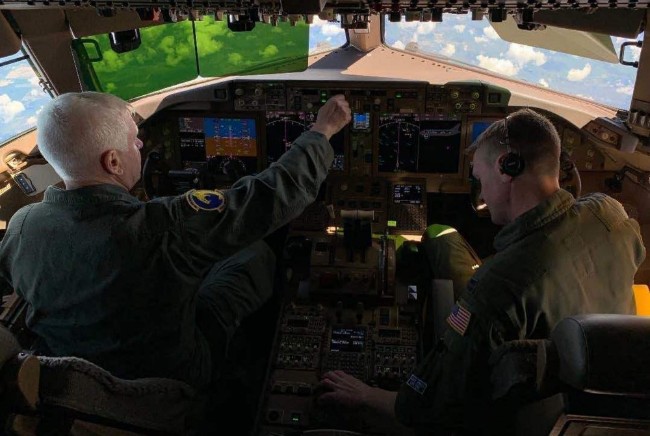
Lt. Gen. L. Scott Rice, left, director of the Air National Guard, and his son Capt. Lee Rice, right, a pilot assigned to the 157th Air Refueling Wing, Pease ANGB, N.H., fly a KC-46A Pegasus Aug. 8, 2019. Air National Guard photo by SSgt. Morgan Lipinski.
The Air Force’s KC-46 program has officially moved the new tanker into its initial operational test and evaluation phase, a delayed step that will certify whether the plane can handle its key missions.
“IOT&E will test the KC-46’s effectiveness, suitability, and mission capability toward accomplishing its three primary mission sets: aerial refueling, cargo/passenger operations, and aeromedical evacuation,” the service said in an Oct. 23 statement. “The Air Force continues to test the new weapon system, while Boeing corrects identified deficiencies in parallel, as the most expeditious means of achieving full operational capability.”
Boeing has delivered 22 of the aircraft to McConnell AFB, Kan.; Altus AFB, Okla.; and Pease ANGB, N.H. The aircraft was conducting pre-test work when multiple “category one” deficiencies arose. Those largely involve the aircraft’s remote vision system, as well as a problem with cargo locks that have limited the KC-46’s ability to carry passengers and cargo.
“Air Force leadership remains concerned with Boeing’s slow progress resolving issues limiting the KC-46’s operational capability and continues to work with Boeing to ensure the KC-46 meets all essential mission requirements,” the service said.
Industry sources have suggested USAF could start IOT&E and save time by scheduling tests that don’t involve air refueling or cargo transport, such as flight evaluations, navigation, and connectivity.
Air Mobility Command boss Gen. Maryanne Miller said last month the top concern is Boeing’s slow progress in meeting all the parameters needed to ensure the remote vision system works properly for USAF boom operators. Issues with the system mean the KC-46 will likely not be deployable for three to four years, Miller said.
Boeing and AMC most recently met Sept. 30 at AMC’s headquarters at Scott AFB, Ill., to discuss the way forward. Boeing proposed solutions that will be studied “to determine if they offer a viable and expeditious path to full operational capability,” the command said in a statement.
Completing IOT&E is the last step before a new weapon system is certified to perform real-world missions without restrictions. The process typically takes a year, and involves testers from the Defense Department and other objective evaluators.